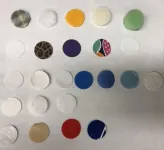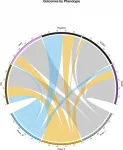(Press-News.org) PHILADELPHIA - A team led by scientists in the Perelman School of Medicine at the University of Pennsylvania has identified nine potential new COVID-19 treatments, including three that are already approved by the Food and Drug Administration (FDA) for treating other diseases.
The team, whose findings were published in Cell Reports, screened thousands of existing drugs and drug-like molecules for their ability to inhibit the replication of the COVID-19-causing coronavirus, SARS-CoV-2. In contrast to many prior studies, the screens tested the molecules for anti-coronaviral activity in a variety of cell types, including human airway-lining cells that are similar to the ones principally affected in COVID-19.
Of the nine drugs found to reduce SARS-CoV-2 replication in respiratory cells, three already have FDA approval: the transplant-rejection drug cyclosporine, the cancer drug dacomitinib, and the antibiotic salinomycin. These could be rapidly tested in human volunteers and COVID-19 patients.
The experiments also shed light on key processes the coronavirus uses to infect different cells and found that the antiviral drug remdesivir, which has an FDA Emergency Use Authorization for treating COVID-19, does appear to work against the virus in cell-culture tests on respiratory cells, whereas hydroxychloroquine does not.
"Our discoveries here suggest new avenues for therapeutic interventions against COVID-19, and also underscore the importance of testing candidate drugs in respiratory cells," said co-senior author Sara Cherry, PhD, a professor of Pathology and Laboratory Medicine and scientific director of the High-Throughput Screening (HTS) Core at Penn Medicine.
Study collaborators included co-senior authors David Schultz, PhD, technical director of the HTS Core, and Holly Ramage, PhD, assistant professor of microbiology & immunology at Thomas Jefferson University.
Although great progress has been made in the development of vaccines and treatments for the SARS-CoV-2 coronavirus, there is still much room for improvement. In the United States, the only antiviral COVID-19 treatments that have received FDA Emergency Use Authorization -- remdesivir and several anti-SARS-CoV-2 antibody preparations -- are expensive and far from 100 percent effective.
For their screening project, Cherry and colleagues assembled a library of 3,059 compounds, including about 1,000 FDA-approved drugs and more than 2,000 drug-like molecules that have shown activity against defined biological targets. They then tested all of these for their ability to significantly inhibit SARS-CoV-2 replication in infected cells, without causing much toxicity.
Initially, they performed antiviral screens using cell types they could grow easily in the lab and infect with SARS-CoV-2, namely African Green Monkey kidney cells, and a cell line derived from human liver cells. With these screens, they identified and validated several compounds that worked in the monkey kidney cells, and 23 that worked in the human liver cells. Hydroxychloroquine, which is used as a malaria drug, and remdesivir, were effective in both cell types.
Since SARS-CoV-2 is mainly a respiratory virus and is thought to initiate infections via airway-lining cells, the researchers sought a respiratory cell type that they could infect experimentally with the virus. They eventually identified a suitable cell line, Calu-3, that is derived from human airway-lining cells. They used these respiratory-derived cells to test the antiviral compounds identified through the human liver cell screen, and found that only nine had activity in the new cells. The nine did not include hydroxychloroquine. (Remdesivir worked in the Calu-3 cells but was not included in the list because it is already in use against COVID-19.)
By identifying different sets of drugs that work in different cell types, the researchers also shed light on the mechanisms SARS-CoV-2 uses to gain entry to cells. The findings suggest that in kidney and liver cells, the virus uses a mechanism that can be disrupted, for example, by hydroxychloroquine; yet the virus appears to use a different mechanism in respiratory cells, thus explaining hydroxychloroquine's lack of success in those cells -- and in COVID-19 clinical trials.
The nine antivirals active in respiratory cells did include salinomycin, a veterinary antibiotic that is also being investigated as an anticancer drug; the kinase enzyme inhibitor dacomitinib, an anticancer drug; bemcentinib, another kinase inhibitor now being tested against cancers; the antihistamine drug ebastine; and cyclosporine, an immune suppressing drug commonly used to prevent the immune rejection of transplanted organs.
The study highlights cyclosporine as particularly promising, as it appears to works against SARS-CoV-2 in respiratory and non-respiratory cells, and via two distinct mechanisms: inhibiting cell enzymes called cyclophilins, which the coronavirus hijacks to support itself, and suppressing the potentially lethal inflammation of severe COVID-19.
"There may be important benefits to the use of cyclosporine in hospitalized COVID-19 patients, and ongoing clinical trials at Penn and elsewhere are testing that hypothesis," Cherry said.
INFORMATION:
The research was supported by funding from the National Institutes of Health (5R01AI140539, 1R01AI1502461, R01AI152362), the Mark Foundation, the Dean's Innovation Fund, the Laddie and Linda Montague Foundation, the Burroughs Wellcome Fund, Mercatus, and the Bill and Melinda Gates Foundation.
A new Veterans Affairs study finds that combat experience is associated with a higher risk of alcohol use to cope with PTSD symptoms. But the connection is weaker when accounting for the severity of the PTSD.
The findings appeared online in the Journal of Dual Diagnosis in March 2021.
In an observational study of more than 11,000 men with at least one traumatic experience, the researchers found that those with combat experience were much more likely than those without to report drinking alcohol to cope with PTSD. The diversity of traumatic experiences, the severity of PTSD, and diagnoses ...
Aquaculture--the farming of fish, shellfish, and other aquatic animals for food--has reached unprecedented levels of growth in recent years, but largely without consideration of its impact on individual animals, finds a new analysis by a team of researchers.
"The scale of modern aquaculture is immense and still growing," says Becca Franks, a research scientist at New York University's Department of Environmental Studies and the lead author of the paper, which appears in the journal Science Advances. "Yet we know so little about the animals that we are putting into mass production, ...
ANN ARBOR--We are made of stardust, the saying goes, and a pair of studies including University of Michigan research finds that may be more true than we previously thought.
The first study, led by U-M researcher END ...
WEHI researchers have discovered a key differentiation process that provides an essential immune function in helping to control cancer and infectious diseases.
The research, published in Science Immunology, is the first to show a new factor - DC-SCRIPT - is required for the function a particular type of dendritic cell - called cDC1 - that is essential in controlling the immune response to infection.
Led by WEHI Professor Stephen Nutt, Dr Michael Chopin and Mr Shengbo Zhang, it defines the role for a new regulatory protein - DC-SCRIPT - in producing dendritic cells.
At a glance
WEHI researchers have uncovered a key step in the formation of a particular type of dendritic cell - called cDC1 - in controlling ...
WEST LAFAYETTE, Ind. -- If you walk with your spouse or partner on a regular basis, you might want to speed up. Or tell them to.
A new study by Purdue University nursing, health and kinesiology, and human development and family studies researchers shows that couples often decreased their speed when walking together. Speed further decreased if they were holding hands.
The study looked at walking times and gait speeds of 141 individuals from 72 couples. The participants ranged from age 25-79 and were in numerous settings, including clear or obstacle-filled pathways, walking together, walking together holding hands and walking individually.
"In our study, we focused on couples because partners in committed relationships often provide essential support ...
Wearing a face mask can protect yourself and others from Covid-19, but the type of material and how many fabric layers used can significantly affect exposure risk, finds a study from the Georgia Institute of Technology.
The study measured the filtration efficiency of submicron particles passing through a variety of different materials. For comparison, a human hair is about 50 microns in diameter while 1 millimeter is 1,000 microns in size.
"A submicron particle can stay in the air for hours and days, depending on the ventilation, so if you have a room that is not ventilated or poorly ventilated then these small particles can stay there for a very long period of time," said Nga Lee (Sally) Ng, associate professor and Tanner Faculty Fellow in the School of Chemical and Biomolecular Engineering ...
New research led by investigators from Boston Medical Center and Grady Memorial Hospital demonstrates the significant decline in hospitalizations for neurological emergencies during the COVID-19 pandemic. The rate of Subarachnoid hemorrhage (SAH) - bleeding in the space between the brain and the tissue covering the brain - hospitalizations declined 22.5 percent during the study period, which is consistent with the other reported decreases in emergencies such as stroke or heart attacks.
Published in Stroke & Vascular Neurology, the study compares subarachnoid hemorrhage hospital admissions for the months following throughout the initial COVID surge, in hospitals that bore ...
In a new study, researchers identify three clinical COVID-19 phenotypes, reflecting patient populations with different comorbidities, complications and clinical outcomes. The three phenotypes are described in a paper published this week in the open-access journal PLOS ONE 1st authors Elizabeth Lusczek and Nicholas Ingraham of University of Minnesota Medical School, US, and colleagues.
COVID-19 has infected more than 18 million people and led to more than 700,000 deaths around the world. Emergency department presentation varies widely, suggesting that distinct clinical phenotypes exist and, importantly, that these distinct phenotypic presentations may respond differently ...
HOUSTON - (April 2, 2021) - Understanding what drives food choices can help high-volume food service operations like universities reduce waste, according to a new study.
Researchers have concluded that food waste in places like university cafeterias is driven by how much people put on their plates, how familiar they are with what's on the menu and how much they like - or don't like - what they're served.
Food waste has been studied often in households, but not so often in institutional settings like university dining commons. What drives food choices in these "all-you-care-to-eat" facilities is different because diners don't perceive personal financial penalty if they leave food on their plates.
Published in the journal Foods, "Food Choice and Waste in University Dining Commons ...
A personalized tumor cell vaccine strategy targeting Myc oncogenes combined with checkpoint therapy creates an effective immune response that bypasses antigen selection and immune privilege, according to a pre-clinical study for neuroblastoma and melanoma. The neuroblastoma model showed a 75% cure with long-term survival, researchers at Children's National Hospital found.
Myc is a family of regulator genes and proto-oncogenes that help manage cell growth and differentiation in the body. When Myc mutates to an oncogene, it can promote cancer cell growth. The Myc oncogenes are ...



